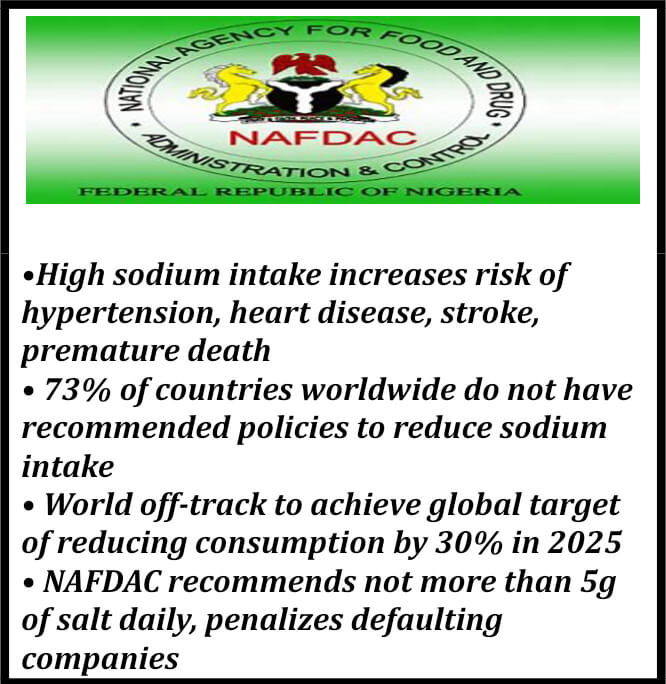By Chukwuma Muanya
A recent survey in Nigeria showed that more restaurants, fast food joints and eateries nationwide serve over-salted foods and they do not comply with the 2 grams sodium per day (equivalent of 5 grams of salt per day) recommended for consumption by the National Agency for Food and Drug Administration and Control (NAFDAC). The investigation revealed that restaurants and packaged foods are often high in salt in an attempt to make them more palatable. It found that sodium plays a key role as a preservative and taste enhancer in packaged foods and that “sodium reduction is complex.”
Another survey showed that sodium content in packaged foods varies a great deal by brand, with a slice of frozen cheese pizza, for example, ranging between 370 milligrams (mg) and 730 milligrams of sodium. Even the items used to make a pizza at home, such as canned tomato sauce and pepperoni can have high sodium levels which consumers may not be aware of. The investigation revealed that food companies are already working to reduce sodium “by offering a variety of products to meet consumer demands – lower sodium, reduced sodium, lightly salted, and no salt options.”
According to World Health Organisation (WHO), sodium, an essential nutrient, increases the risk of hypertension, heart disease, stroke and premature death when eaten in excess. The main source of sodium is table salt (sodium chloride), but it is also contained in other condiments such as sodium glutamate. The survey was informed by complaints from Nigerians that many popular fast food joints normally serve over-salted foods to customers.
The survey was corroborated by a first-of-its-kind WHO Global report on sodium intake reduction, published last month, which showed that only five per cent of WHO member states were protected by mandatory and comprehensive sodium reduction policies and that 73%, including Nigeria, lacked full range of implementation of such policies. The WHO Global report on sodium intake reduction showed that the world was off-track to achieving its global target of reducing sodium intake by 30% by 2025, although all 194 WHO member countries committed to the target set in 2013.
The global average salt intake is estimated to be 10.8 grammes per day, more than double the WHO recommendation of less than five grammes of salt per day (one teaspoon). Eating too much salt makes it the top risk factor for diet and nutrition-related deaths. More evidence is emerging, documenting links between high sodium intake and increased risk of other health conditions such as gastric cancer, obesity, osteoporosis and kidney disease.
- High sodium intake increases risk of hypertension, heart disease, stroke, premature death
• 73% of countries worldwide do not have recommended policies to reduce sodium intake
• World off-track to achieve global target of reducing consumption by 30% in 2025
• NAFDAC recommends not more than 5g of salt daily, penalizes defaulting companies

Former President, Nutrition Society of Nigeria (NSN), Prof. Ngozi Nnam, says that salt is a good source of sodium, an essential mineral for the body. Nnam, however, said if a person consumes too much salt, he or she may be at risk of certain health conditions. Salt is present in a wide range of foods and drinks. Salt may occur naturally in certain foods, or manufacturers may add salt during the production process.
The Professor of Community and Public Health Nutrition, affiliated to the Department of Nutrition and Dietetics at the University of Nigeria Nsukka, Enugu State, said: “The major concern about salt is that when you take a lot of it, it causes an imbalance in terms of electrolyte because there is a drastic increase in sodium. The tendency is that there is a high concentration of sodium and the water balance is also distorted. The body system will try to restore the balance and this will affect the way water is pumped into the kidney and the way blood is pumped into the heart. This is because the body is trying to get a balance. The rate blood is pumped into the heart increases and also there is a concomitant increase in blood pressure. This imbalance also affects the kidney and could lead to kidney dysfunction and damage. The ways in which too much sodium can harm the body are well understood. Too much sodium leads the body to retain water, which is pulled into the blood vessels. This can increase the volume of blood. It is like turning up the water supply to a garden hose — the pressure in the hose increases as more water is blasted through it. And, over time, this leads to disease. The kidneys get stressed, the blood vessels get stressed, the heart gets stressed.”
On what NAFDAC is doing to ensure that food outlets comply, its Director General, Prof. Mojisola Adeyeye, said the agency is sustaining awareness creation on health risks associated with high salt consumption. On the penalty for defaulting companies, Adeyeye said, as regulators, the response to gaining positive health outcomes does not necessarily have to be penalizing defaulting companies, but rather obtaining their buy-in and commitment to produce foods that offer good nutrition. “This is why we are more focused on creating awareness on the ills of highly salted foods to health,” she said.


On why NAFDAC has not set an example considering the fact that popular outlets sell over salted foods, Adeyeye said the agency’s regulatory measures involve encouraging food outlets to ensure that the salt content is reduced during food preparation and for consumers to be well informed on the ills of highly salted foods and, therefore, contribute to driving the demand for less salty foods.
What is NAFDAC’s position on this issue?
The pharmacist said the agency’s position is to continue to ensure that dietary sodium intake is reduced in the population, as it is recognised as one of the most cost-effective ways to improve health and nutrition. She added that NAFDAC, as an agency responsible for the regulation and control of food in Nigeria, has introduced some strategies and regulations to ensure food producers make healthy products available to the population. Adeyeye said one of the approaches adopted by the agency is implementation of mandatory nutrition labelling of packaged foods to enable consumers make informed decisions and choices on their food nutrient intake, including salt.
Adeyeye added: “Furthermore, NAFDAC is collaborating with academia, non-governmental organisations and other stakeholders in research and monitoring of population’s salt intake, sources of salt in the diet and consumer knowledge, attitudes and practices relating to sodium or salt intake to inform policy decisions.” The NAFDAC DG said besides hypertension, high salt content increases the risk of heart disease and stroke.
On what NAFDAC was doing on enforcement, especially in fast foods and confectioneries, like biscuits, she said: “NAFDAC already has an approved food grade table or cooking salt regulation which has been passed into law. This is to ensure the quality of food-grade salt in Nigeria. NAFDAC and some non-state actors are currently developing a framework for the reduction of salt in processed foods.”
On recommended salt limit in Nigeria, Adeyeye said that Nigeria is a WHO member state and works with WHO global recommendation of consumption of dietary sodium at levels less than 2 grams a day of sodium (less than 5 grams per day of salt). Adeyeye said Nigeria is currently working in line with the WHO target of reducing dietary sodium consumption by 30% by 2025. The NAFDAC D-G said the reduction of salt in food, due to its associated risks with cardiovascular diseases, is a national burden and the implementation of its reduction requires the action and collaboration of all stakeholders.
Adeyeye said on 6 August 2019, in Abuja, Nigeria launched her first “National Multi-Sectoral Action Plan (NMSAP) for the Prevention and Control of Non-Communicable Diseases 2019 – 2025. She said this policy advocates for a multisectoral approach to reduce sodium in food by 30% by the year 2025. She also said as part of the implementation plan, NAFDAC was collaborating with the Cardiovascular Research Unit of the University of Abuja where a project, titled “Evaluating the Implementation and Scale-Up of Nigeria National Sodium Reduction Programme”, is being conducted, also in collaboration with the Federal Ministry of Health and other partners and stakeholders. This, she said, is in recognition of the fact that data is the driver of all impactful action.
Adeyeye said this project is critical as it will generate data to inform salt reduction strategies in Nigeria. She said the first phase of this project had been conducted and incidentally, NAFDAC, together with the University of Abuja and partners, had planned to host a stakeholders’ meeting to share the results, engage stakeholders in discussions and increase awareness of the positive impact of salt reduction on health in the food industry, among policymakers, consumers and other stakeholders.
Asked what the other concerns about salt intake in Nigeria besides hypertension were, Adeyeye said: “Cardiovascular diseases with high blood pressure are a major risk associated with sodium intake found in salts. The disease burden attributable to excess sodium consumption in Nigeria is large, with 10% of all deaths from cardiovascular diseases coming from dietary sodium. High intakes of sodium are associated with progression of chronic kidney diseases. In relation to osteoporosis – a bone-thinning disease – the amount of calcium loss via urination increases with the amount of salt taken. Diets with high sodium may have an additional unwanted effect. Stomach cancers are associated with higher intakes of salt. Asked if there was any alternative to salt, the Professor said: “I am not aware of any alternative to salt.” On whether there were any benefits to extra salt intake, considering the recommendation in diarrhoea and some viral infections, she said: “I am not aware of any.”
Implementing highly cost-effective sodium reduction policies could save an estimated seven million lives globally by 2030. It is an important component of actions to achieve the Sustainable Development Goal (SDG) of reducing deaths from non-communicable diseases. But today, only nine countries – Brazil, Chile, Czech Republic, Lithuania, Malaysia, Mexico, Saudi Arabia, Spain and Uruguay – have a comprehensive package of recommended policies to reduce sodium intake.

WHO Director-General, Dr. Tedros Adhanom Ghebreyesus said: “Unhealthy diets are a leading cause of death and disease globally and excessive sodium intake is one of the main culprits.” A report shows that most countries are yet to adopt any mandatory sodium reduction policies, leaving their people at risk of heart attack, stroke and other health problems. WHO calls on all countries to implement the ‘Best Buys’ for sodium reduction, and on manufacturers to implement the WHO benchmarks for sodium content in foods.
A comprehensive approach to sodium reduction includes adopting mandatory policies and WHO’s four ‘best buy’ interventions related with sodium which greatly contribute to preventing non-communicable diseases. These include: reformulating foods to contain less salt and setting targets for the amount of sodium in foods and meals; establishing public food procurement policies to limit salt or sodium-rich foods in public institutions such as hospitals, schools, workplaces and nursing homes; front-of-package labelling that helps consumers select products lower in sodium; and behaviour change communication and mass media campaigns to reduce salt or sodium consumption.
Countries are encouraged to establish sodium content targets for processed foods, in line with the WHO Global Sodium Benchmarks and enforce them though these policies. Mandatory sodium reduction policies are more effective. They achieve broader coverage and safeguard against commercial interests and provide a level playing field for food manufacturers. As part of the report, WHO developed a sodium country scorecard for member states based on the type and number of sodium reduction policies they have in place. President and Chief Executive Officer (CEO) of Resolve to Save Lives, a not-for-profit organisation working with countries to prevent 100 million deaths from cardiovascular disease over 30 years, Dr. Tom Frieden, said: “This important report demonstrates that countries must work urgently to implement ambitious, mandatory, government-led sodium reduction policies to meet the global target of reducing salt consumption by 2025. There are proven measures that governments can implement, and important innovations, such as low sodium salts. The world needs action now or many more people will experience disabling or deadly—but preventable—heart attacks and strokes.”

WHO urged member states to implement sodium intake reduction policies without delay to mitigate the harmful effects of excessive salt consumption. WHO also called on food manufacturers to set ambitious sodium reduction targets in their products.
WHO has partnered with Resolve to Save Lives to support countries around the world to reduce sodium consumption. Resolve to Save Lives recently published a Global Nutrition Database for Packaged Foods, which currently presents packaged food nutrient data for 25 countries. Since 2017, Bloomberg Philanthropies has supported Resolve to Save Lives’ global efforts to save lives from cardiovascular diseases. The WHO Global Sodium Benchmarks target a wide range of categories of processed and packaged food products that significantly contribute to overly salty diets. Processed and packaged bread, savoury snacks, meat products and cheese are among the categories of high-sodium food products identified for the new global benchmarks.
Reducing sodium content by reformulating processed foods is a proven strategy to reduce population sodium intake, particularly in places where consumption of processed foods is high. It can also prevent processed foods from becoming a major source of sodium in countries where its consumption may be rapidly increasing. In the United Kingdom, voluntary targets for food manufacturers to reformulate products decreased adult salt intake approximately by 15% between 2003 and 2011, indicating that target-setting across multiple food categories can achieve meaningful reductions in sodium consumption.
Meanwhile, a new study published recently demonstrated that high-salt diet is a danger even with normal blood pressure. It is well known that high blood pressure is a risk factor for heart attacks and strokes. Now, new research from Sweden has shown that too much salt in the diet is an important risk factor for clogged arteries in the neck and heart, increasing the risk of heart attacks and strokes even if you don’t have high blood pressure. The study was published online in European Heart Journal Open.
The finding raises the possibility that salt could cause damage even before someone develops high blood pressure, said study author Jonas Wuopio, MD, of the Karolinska Institutet, Huddinge, and Clinical Research Centre at Uppsala University in Sweden.
Salt is bad for heart health because of its link to high blood pressure, also known as hypertension, but the role salt plays in the development of plaque in the arteries has not been examined, Wuopio said. “Ours is the first study to examine the association between a high salt intake and hardening of the arteries in both the head and neck. The association was linear, meaning that each rise in salt intake was linked with more atherosclerosis,” he said.

The study included 10,778 adults aged 50 to 64. The research team measured the amount of salt found in their urine to estimate their salt consumption. The researchers then captured images of the arteries of the heart to check for calcium and blockages or stenosis, and ultrasound to detect blockages in the carotid arteries in the neck. They found that the more salt people consumed, the higher their risk of calcifications in the heart and neck arteries. The findings were seen even after the researchers excluded people with high blood pressure. “This means that it’s not just patients with high blood pressure or heart disease who need to watch their salt intake,” Wuopio said. He tells his patients to follow guidance from the World Health Organization and other groups to limit salt to about a teaspoon a day. “It can be hard to estimate how much salt we eat, so I advise patients to limit the use of table salt, or to replace salt with a salt substitute,” he said.
The lower you can get your blood pressure, the better, said Alon Gitig, MD, an assistant professor and director of cardiology for Mount Sinai Doctors in Westchester, New York. “Everybody knows that high blood pressure is associated with future cardiovascular disease risk, but what many don’t realize is that that risk starts to increase” even at the upper end of what is considered normal. Most of the people in the U.S. over the age of 60 have hypertension,” Gitig said.
A good way to lower your blood pressure is through diet, exercise, and maintaining a healthy weight, he said. The Dietary Approaches to Stop Hypertension (DASH) diet – which suggests several servings of fruits and vegetables a day, with few refined carbohydrates, flour, and sugar – have been shown in a study to dramatically lower blood pressure, Gitig said. “There are two reasons for that. One is that fruits and vegetables have many phytonutrients that are good for our arteries. The other is that most of U.S. adults have insulin resistance, and insulin resistance leads to high blood pressure. Eating more fruits and vegetables and lean meats while limiting sugar and flour will improve insulin resistance. Do that, Gitig said, “and you can bring your blood pressure down that way.”
According to research by Queen Mary University of London, England’s salt reduction programme will have led to nearly 200,000 fewer adults developing heart disease and £1.64 billion of healthcare cost savings by 2050. However, the researchers warn that the recent stalling of salt reduction programmes is endangering the potential health gains, as salt intake remains significantly higher than recommended levels. Excess salt intake is strongly linked with raised blood pressure and increased risks of cardiovascular disease, as well as kidney disease, gastric cancer and osteoporosis. Raised blood pressure is responsible for half of the burden of ischemic heart disease and more than 60% of strokes. The new research, published in the journal Hypertension, used 2000-2018 population survey salt intake data and disease burden data to project the impact of the salt reduction programme and found that the 2003 to 2018 salt reduction programme in England achieved an overall salt intake reduction of 1 gram a day per adult, from 9.38 grams a day in 2000 to 8.38 grams a day in 2018. If 2018 salt intake levels are maintained, by 2050 the programme would have led to 193,870 fewer adults developing premature cardiovascular disease comprising of 83,140 cases of premature ischemic heart disease and 110,730 premature strokes, and £1.64 billion of healthcare cost savings for the adult population of England.
If the World Health Organization recommended salt intake of 5 grams a day is achieved by 2030 in England, these benefits could double, preventing a further 213,880 premature cardiovascular disease cases and further health and social care savings to the UK government of £5.33 billion. And most recently, a study published in The New England Journal of Medicine from China points to similar benefits. When groups of people in Chinese villages substituted potassium chloride for table salt, “they saw significant reductions in heart attacks and strokes.




